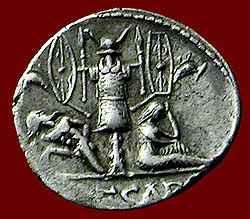This article needs additional citations for verification .(November 2025) |

A trophy or trophy of arms in art and architecture is a real or depicted artistically assembled display of weaponry and other militaria, often captured from a defeated enemy, as an ornament designed for the purpose of triumphalist display by a victor or as a show of military prowess by a monarch. [1] Similar decorative vertical arrangements of hunting accessories, musical instruments or other objects are also commonly referred to as trophies.
Contents
The term comes from the ancient Greek tropaion and Roman equivalent tropaeum, military victories which were commemorated with a display of actual captured arms, armour and standards. The use of trophies as an ornament in decoration became popular in the Italian Renaissance, and as an architectural element in relief or free-standing sculpture during the Baroque era, where they are often used as a kind of finial to decorate rooflines, gate columns and other elements of buildings with military associations, which included most royal palaces.
The Triumphs of Caesar by Andrea Mantegna (1482–94, now Royal Collection) are a series of paintings of the Roman triumph of Julius Caesar that soon became enormously influential in print form. They showed trophies carried on carts and on poles, and probably gave a big impetus to the trend for ornament prints of trophies, which were then copied into a range of media.









